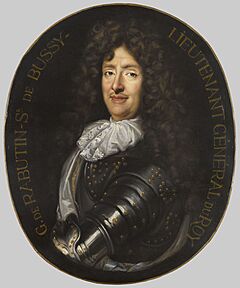Roger de Rabutin, comte de Bussy facts for kids
Roger de Rabutin, comte de Bussy (born April 13, 1618 – died April 9, 1693), known as Bussy-Rabutin, was a French writer. He was famous for writing his own life story. He was also a cousin of Madame de Sévigné and they often wrote letters to each other.
Contents
Early Life and Family
Roger was born in Epiry, France. His family was important in Burgundy. His father, Léonor de Rabutin, was a high-ranking officer. Roger was the third son in his family. But his older brothers died, so he became the main heir.
Education and First Steps
He went to school with the Jesuits in Autun. Then he studied at the College de Clermont. When he was only sixteen, he joined the army. He fought in many battles. He took over his father's military role. In 1634, he helped in the siege of La Mothe-en-Bassigny.
Early Troubles
Roger wanted to be a good person and a brave soldier. But he often had bad luck. In 1641, he was sent to the Bastille prison. This was because he didn't focus on his army duties. Richelieu ordered his arrest. He stayed in prison for several months.
Military Career and Personal Life
In 1643, Roger married his cousin, Gabrielle de Toulongeon. He left the army for a short time. But in 1645, he returned to his father's old position. He served under Condé in Catalonia.
Second Marriage
His wife Gabrielle died in 1646. Later, he married Louise de Rouville.
The Fronde and Royal Service
When Prince Condé joined the Fronde, Roger first joined him. The Fronde was a civil war in France. But Roger felt Condé treated him badly. So, he switched sides to support the king. He fought well in the civil war. He also served in wars abroad. In 1655, he bought a new military rank. He then served under Turenne in Flanders.
Battles and Conflicts
He fought in several campaigns there. He was brave at the Battle of the Dunes (1658). But he did not get along with his general. He often argued with people. He also wrote critical songs about others. This made many important people dislike him.
Exile and Later Life
On April 17, 1665, Roger was sent to the Bastille again. He stayed there for over a year. He was set free only if he went back to his family's estates. He lived there in exile for 27 years. He felt very sad about this disgrace. It was even harder for him that his military career ended.
Return to Court and Death
In 1682, he was allowed to visit the royal court. But people there were not friendly to him. He preferred his quiet life in Burgundy. So he went back home. He died there in 1693.
Academic Recognition
In 1665, he was chosen to join the Académie française. This is a very important French academy. He remained a member until he died.
Famous Writings
Roger de Bussy-Rabutin wrote several important books.
Histoire amoureuse des Gaules
One of his most famous works is Histoire amoureuse des Gaules. This book is known for its unique style. It includes famous descriptions of people. These include his cousin Madame de Sévigné and Prince Condé.
Mémoires
His Mémoires (memoirs) were published after he died. These are his own life stories. They are very lively and interesting. They read like an exciting adventure story.
Letters and Other Works
He also wrote many letters. His collection of letters is very large. It is one of the most interesting collections of its kind. It even includes many letters from Madame de Sévigné. Her letters were first published in his collection. Historians and writers find his works very valuable.
Roger also wrote other things. His Genealogy of the Rabutin Family was a family history. It was published much later in 1867. He also wrote a book called Considerations sur la guerre (Thoughts on War). This was first published in 1746. He also wrote biographies for his children. In these, his own life served as a lesson.


